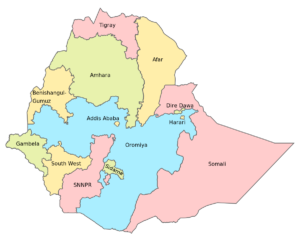Ancient Roots: A Promising New Project To Organize Humanity’s Universal Heritage

Eric Laursen
An international group of researchers and data scientists are creating a comprehensive database of the world’s archaeological knowledge—and changing our understanding of humans’ prehistoric heritage.
Archaeology isn’t what it was in Indiana Jones’s heyday. The traditional image of the khaki-clad researcher scrambling over an excavation site with rock hammer and camel-hair brush has been supplemented by aerial and satellite photography, CT scanners and 3D modeling, and lidar that can isolate the smallest details of long-buried settlements. What archaeologists do with the artifacts and data they gather is changing dramatically as well, as they use network science and new software tools to map the complex connections between regional economic networks in the millennia before written history.
With this new, technology-driven approach, researchers can form a far more comprehensive picture of early communities’ ties with other human clusters sometimes thousands of miles away, by examining the goods and raw materials they exchanged and tracing these from their points of origin to the far-flung places where they were abandoned and then rediscovered centuries later. This is yielding additional insights into social inequality and power relations within communities, differences and similarities between communities living next to each other, and patterns of migration and settlement.
“You get more of a sense of a dynamic,” says Tim Kerig, an archaeologist at Kiel University’s ROOTS Cluster of Excellence in Social, Environmental, and Cultural Connectivity in Past Societies, in Germany, “of people coming from other places and how, over the generations, they filled that landscape. So we’re looking at the whole system, over not centuries but millennia.”
Network science is the study of complex relationships—and probable relationships—between physical, biological, social, and cognitive phenomena. Applying network science to archaeology was an idea in the minds of researchers as far back as the 1960s, says Kerig, whose own work focuses on the European Neolithic period—from about 8000 BC to 2000 BC—and the evolution of social inequalities. But while interest grew in succeeding decades, archaeologists lacked the tools to easily collate and analyze the millions of data points that had been gathered over many decades. The few efforts to do so proceeded punishingly slowly, on top of which, there was less interest at the time in exploring the connections that material and economic exchanges between far-flung communities could reveal.
“Sociological questions were mostly answered by looking at goods that were found in graves—the ‘sphere of kings’—which tended to be highly valued luxury items,” Kerig says, while archaeologists were less interested in “the daily stuff”: fragments of flint or stone objects or implements that made up the fabric of most people’s everyday lives. This was partly due to an overabundance of these humbler items. “Don’t forget that at a Stone Age site in Denmark, for example, you might have 100,000 artifacts to deal with, and they all look to most of us exactly the same.”
“Big Exchange” is the name of a project that an international cluster of scholars and data scientists, including Kerig, launched in 2020 with the aim of using digital tools to break down the barriers to applying network science to archaeology. The most critical hurdle they faced was overspecialization. Traditionally, archaeologists have focused on specific objects or raw materials—amber, obsidian, jade, flint, other metals—rather than the totality of findings at a given site, which prevented them from seeing the totality of that community’s networks of exchange. Big Exchange’s first objective is to create a database that collates all these materials and makes them available for more sophisticated, cross-referenced study and analysis.
“The approach of our project is to include all recordable raw materials, their find locations and places of origin in the analysis for the period from the end of the Middle Stone Age [or Mesolithic, 10,000 years ago,] to Antiquity,” Johanna Hilpert, a Big Exchange postdoc researcher at the ROOTS Cluster, told Phys.org in July 2023. “This can only be done by means of network analysis and with AI [artificial intelligence].” Read more
How Countries Prepare For Population Growth And Decline

John P. Ruehl – Source: Independent Media Institute
09-11-2023 ~ Around the world, diverse initiatives are being introduced to manage population changes.
In early 2023, India surpassed China as the most populous country in the world with the latter having 850,000 fewer people by the end of 2022—marking the country’s first population decline since famine struck from 1959 to 1961.
While this reduction may seem modest considering China’s 1.4 billion population currently, an ongoing decline is anticipated, with UN projections suggesting that China’s population could dwindle to below 800 million by 2100.
Populations fluctuate through immigration, emigration, deaths, and births. China’s previous one-child policy, enforced from 1980 to 2015, and the resulting gender imbalance slowed its birth rate. The Chinese government is now trying to boost birth rates, including by discouraging abortion.
The Malthusian population growth model, proposed in the 1700s, suggested that populations grow exponentially and outpace resource availability until inevitable checks, such as famine, disease, conflict, or other issues, cause it to drop. During the high global population growth rates of the early 1960s, these concerns abounded. Yet around the world, population growth has slowed dramatically, and in China and many other countries, natural decline is already underway.
A 2020 study published in the Lancet medical journal revealed that based on current population trends, more than 20 countries are on track to halve their populations by 2100. The Pew Research think tank, meanwhile, declared that 90 countries will see their populations decline by 2100, while the Center of Expertise on Population and Migration (CEPAM) predicts the global population will peak at 9.8 billion around 2070 to 2080.
The fear of a shrinking and aging population looms over governments and economists alike. Increased payments toward pension and social welfare systems will strain a reduced labor force, while younger populations also contribute more to economic growth and innovation. Countries may also experience a reduction in their global influence—not least because of a smaller population available for military service.
Various metrics gauge fertility and birth rates, but the total fertility rate (TFR), which measures the number of children a woman will have in her lifetime, is the most common. Yet achieving replacement level fertility rates, typically 2.1 children per woman, has proven challenging.
The decline in global fertility rates can be attributed to societal and cultural shifts, family planning initiatives, wider access to contraception, improved infant mortality rates, increased cost of child-rearing, urbanization, delayed marriages and childbirth due to educational and career pursuits, and social welfare systems reducing reliance on familial support.
A case in point is Japan, whose population peaked at 128 million in 2008 and has since shrunk to below 123 million. It is poised to decrease to 72 million by century’s end, its decline sustained by a low fertility rate, an aging population (almost 30 percent of the population is 65 or older), and limited immigration. Initiatives to slow this decline include changing immigration laws and government-sponsored speed dating.
Remarkably, despite hitting a record low in 2022, Japan’s TFR is now higher than China’s and South Korea’s. Since 2006, South Korea has invested more than $200 billion in establishing public daycare centers, free nurseries, subsidized child care, and other initiatives to boost its TFR. But at 0.78, South Korea’s TFR remains the world’s lowest. South Korea’s government also introduced immigration reforms in the early 21st century, all while leading the world in automation with 1,000 robots per 10,000 employees—more than double of second-ranked Japan. Read more
Economic Growth In G7 Versus BRICS: A Reality Check

Richard D. Wolff
In the United Kingdom, the BBC prepared and published data from the International Monetary Fund (IMF) in January about different nations’ growth forecasts for 2023 and 2024. The BBC foregrounded some really bad news for the UK. Of nine major industrial economies—the G7 (the U.S., Canada, Japan, Germany, the UK, France, and Canada), plus Russia, and China—the UK would be the only one to suffer real economic decline: a contraction in its 2023 GDP (its total annual, national output of goods and services). So dubious a distinction for the UK followed the long political night of rule by the Conservative Party. That night’s darker moments included austerity after the severe 2008-2009 global capitalist crash, scapegoating Europe for the UK’s economic troubles, Brexit taking place during the peak of that scapegoating, enjoyment of COVID cocktail parties by former Prime Minister Boris Johnson’s government that it prohibited for the British public, and endless, transparent, and cringeworthy lying to the public when caught and exposed. But the BBC’s report on the new IMF data was shocking about far more than the poor performance of the UK economy.
For the rest of 2023, the IMF says China’s GDP will grow more than 5 percent or more than twice Japan’s GDP growth rate. All other G7 countries will grow their GDPs more slowly than Japan. China’s growth rate will be more than triple that of the U.S. in 2023. Finally, the IMF’s projected GDP growth for 2024 shows both Russia and China growing much faster than any G7 country. These comparative forecasts comprise a reality check that clashes with most politicians’ statements, mass media accounts, and propaganda barrages (worsened by the Ukraine war) emerging from the G7’s old capitalist establishment. The BBC report was thus both rare and arresting.
For 30 years, skepticism and disparagements confronted China’s claims about its economic growth. When these attempts to debunk Beijing’s claims were subsequently proven wrong by the country’s stunning record of superior economic growth, the intensity of these efforts nonetheless mounted. Disbelief in China’s economic achievements grew even as in-person visits to China confirmed high rates of industrialization, internal migration and urbanization, and fast-rising mass consumption levels. The need to disregard China’s economic transition from extreme poverty to economic superpower status rivaling the U.S. reminds us of the Cold War-driven nonrecognition of Soviet economic achievements after 1945. A parallel nonrecognition figures again in the G7 sanctions strategy against Russia over the Ukraine war. For anyone seriously interested in understanding the momentous changes now sweeping across the world economy, one question looms. How do we account for the gap between what the old capitalist establishment says (and may even believe) and what is real?
The answer is that we are confronted with a combination of denials and pretenses that are caused by the conjoined decline of U.S. capitalism and its global empire (or hegemony). Those declines have occasionally become clear enough, at least fleetingly, to observers within the old capitalist establishment. For example, such key moments include the U.S. military’s inability to “win” local wars even against poor countries such as Afghanistan and Iraq. Another example was the U.S. medical-industrial complex’s subpar performance in managing the high number of COVID deaths and illnesses. U.S. capitalism’s crash in 2020 and into 2021 was severe and then was followed immediately by a bad inflation and then a fast, destabilizing tightening of credit: not exactly a stellar economic record. Debt levels of the U.S. government, corporations, and households are at or near record levels. Inequalities of wealth and income, already extreme, keep rising. A public viewing such facts might reasonably wonder whether something bigger is at play beyond these events being seen in isolation. Might there possibly be a systemic problem?
But before such a line of thought can jell into a conscious question, let alone any serious pursuit of an answer, denial sets in. A systemic breakdown seems an unbearable thought, so denial of systematicity is undertaken. Statements about specifics are carefully crafted to omit connecting them to their context of a declining capitalist system. Evasion of the systemic dimension leads to undervaluing the dangers each particular problem or crisis presents. Like rose-colored glasses, anti-systemic glasses make economic problems appear less dangerous, narrower, and more limited in effects than they actually are. The anti-systemic bias is a form of denial. Read more
Neocolonial Debt Traps Are Forcing Poorer Countries To Rely On Fossil Fuels

Tess Woolfenden – Photo: Debt Justice
To break our global dependence on fossil fuels, we must take on neocolonial debt, researcher Tess Woolfenden says.
In the current age of climate emergency, many countries in debt are being forced by Global North elites and institutions to continue to rely on fossil fuels in order to repay loans taken from rich countries. This neocolonial debt trap creates a vicious cycle because — as a new analysis from the organization Debt Justice shows — revenues from fossil fuels are not enough to repay debts and instead leave countries even deeper in debt while at the same time worsening the prospects of achieving the goal of zero global emissions by 2050.
This debt trap is one of many ways in which colonialism continues to shape the current era. While dozens of countries gained independence through successful decolonization struggles after World War II, colonialism persists through the use of economic and political pressures to control “dependencies” as a means of reinforcing global capitalism.
In the exclusive interview for Truthout that follows, Tess Woolfenden, senior policy and research officer at Debt Justice and the author of the aforementioned report, discusses the dynamics between debt and fossil fuels, highlights the consequences of fossil fuel colonialism and offers concrete policy solutions for breaking the cycle.
C. J. Polychroniou: Tess, it’s a well established scientific fact that greenhouse gases like carbon dioxide (CO2) cause global warming. The burning of fossil fuels — coal, oil and gas — accounts for over 75 percent of greenhouse gas emissions and 90 percent of carbon dioxide emissions, making them the largest contributor to global climate change. Yet, fossil fuels still account for more than 80 percent of global energy production and the energy transition proceeds very slowly. In fact, it is projected that by 2023, “fossil fuels will still account for 78 percent of the global energy mix.” Why is it so hard to phase out fossil fuels?
Tess Woolfenden: Very simply, the people with the power to phase out fossil fuels — governments, corporations and institutions — do not want to. The fossil lobby is powerful, and with huge profits to be made ($52 trillion since 1970 reportedly), it is in their interests for the world to keep burning fossil fuels despite the devastating consequences.
For years, climate justice activists have fought to get the powerful global north governments, institutions, corporations and billionaires overwhelmingly responsible for creating the climate crisis to transition to clean, renewable energy. But despite making various commitments over the years, phasing out fossil fuels is still not happening. For example, at COP26 governments committed to phasing out fossil fuel subsidies, yet just last week research by the International Institute for Sustainable Development showed that the world’s richest governments put a record $1.4 trillion into subsidising oil, coal and gas in 2022. Rich governments clearly do not see these commitments as binding.
In the case of many Global South countries, we also must consider their long-standing dependency on fossil fuels. For decades, Global South governments have been reliant on their natural resources, including fossil fuels, to keep their economies going and to repay high debt burdens. This dates back to colonialism where, under European rule, countries’ economies were transformed to focus on the export of raw materials such as oil and coal, to feed industrial growth taking place in Europe. The ongoing extraction of resources and inequalities in the global trade, tax and financial systems have meant that Global Aouth countries have not been able to diversify their economies, and remain reliant on commodity exporting even today — many refer to this as the “commodity dependency trap.” What’s more, Global North governments and Global North-dominated institutions like the International Monetary Fund (IMF) and World Bank have extended this trap by encouraging and enforcing Global South reliance on commodity exporting, through, for example, conditions attached to loans. This has kept countries poor and reliant on loans; it has also guaranteed cheap access to Global South countries’ natural resources. So, for many Global South countries, phasing out fossil fuels also requires us to dismantle deep long-standing inequalities etched into our global systems.
Debt Justice, a U.K.-based organization, has just released a report, titled “The Debt-Fossil Fuel Trap,” which you actually wrote, on the links between debt and fossil fuel production in Global South countries. But before we get into those links, what do you make of the argument that Global South countries should be allowed to continue relying on the burning of fossil fuels for development purposes while the Global North countries reduce their carbon footprint?
I understand this argument. It comes from a place of recognizing that the Global North has used up more than its fair share of atmospheric space and has been able to develop and profit in the process, while Global South countries bear the worst impacts of the climate crisis. Why should countries in the Global South now not be able to do the same?
But as many groups in the Global South highlight, to do so would lead us further down the path of climate catastrophe. It would also maintain Global South countries’ reliance on fossil fuels, extending commodity dependency and the economic injustices and challenges this presents.
Instead, in the global debt movement we call on rich, polluting governments, institutions and corporations to pay their “climate debt” — the debt they owe for the destruction of the climate crisis they caused — and to provide reparations. These are broad, expansive demands that would allow Global South countries to put an end to their reliance on fossil fuels and have the resources they need to transition to clean, renewable energy. Read more
Is Intellectual Property Turning Into A Knowledge Monopoly?
 The twentieth century saw the emergence of public funded universities and technical institutions, while technology development was concentrated in the R&D laboratories of large corporations. The age of the lone inventor—Edison, Siemens, Westinghouse, Graham Bell—had ended with the nineteenth century. The twentieth century was more about industry-based R&D laboratories, where corporations gathered together leading scientists and technologists to create the technologies of the future. In this phase, capital was still expanding production. Even though finance capital was already dominant over productive capital, the major capitalist countries still had a strong manufacturing base. In this phase of development, science was regarded as a public good and its development was largely concentrated in the university system or publicly funded research institutions. Technology development was largely regarded as a private enterprise. Science was supposed to produce new knowledge, which could then be mined by technology to produce artifacts. The role of innovation was to convert ideas into artifacts. The system of intellectual property—patents and other rights—arose to provide protection to the useful ideas embodied in artifacts. From the beginning, patents also had a public purpose—the state-granted monopoly for a certain period was meant to ensure the eventual public disclosure of the invention: the quid pro quo being full public disclosure in lieu of a limited-term monopoly.
The twentieth century saw the emergence of public funded universities and technical institutions, while technology development was concentrated in the R&D laboratories of large corporations. The age of the lone inventor—Edison, Siemens, Westinghouse, Graham Bell—had ended with the nineteenth century. The twentieth century was more about industry-based R&D laboratories, where corporations gathered together leading scientists and technologists to create the technologies of the future. In this phase, capital was still expanding production. Even though finance capital was already dominant over productive capital, the major capitalist countries still had a strong manufacturing base. In this phase of development, science was regarded as a public good and its development was largely concentrated in the university system or publicly funded research institutions. Technology development was largely regarded as a private enterprise. Science was supposed to produce new knowledge, which could then be mined by technology to produce artifacts. The role of innovation was to convert ideas into artifacts. The system of intellectual property—patents and other rights—arose to provide protection to the useful ideas embodied in artifacts. From the beginning, patents also had a public purpose—the state-granted monopoly for a certain period was meant to ensure the eventual public disclosure of the invention: the quid pro quo being full public disclosure in lieu of a limited-term monopoly.
The transformation of this system that had existed for several centuries came about as a result of two major changes in the production of knowledge. The first relates to the way in which, under the neoliberal order, the university system of knowledge production has been transformed into a profit-making commercial enterprise. Secondly, the distinction between science and technology has blurred considerably and the two are more closely integrated than before. For example, an advance in genetics can almost seamlessly lead to an artifact—a drug, a diagnostic tool or a seed—that is both patentable and marketable. Similar is the case of innovations in the field of electronics and communications. Many disciplines of science and also research output in universities, are, in consequence, driven closer to the systems of production. The conversion of the university system into a system producing knowledge directly for commercial purposes has happened in tandem with the destruction of the R&D laboratories that were so much a part of the industrial landscape of the twentieth century. Finance capital controls university science, not just through “investment” in R&D, but also the purchase of “knowledge”. Its monopoly is exercised through buying the patents that university research produces. This monopoly in turn allows finance capital to dominate over industrial capital.
The end of the twentieth century revealed the rupture of finance capital and productive capital. Today, global capital operates far more as disembodied finance capital, controlling production at one end with its control over technology and markets at the other. In this phase, where capital increasingly lives off speculation and rent, there is also a marked separation of knowledge as capital from productive or physical capital—plant and machinery. Foxconn/Hon Hai Precision Industries manufactures Apple products but cannot claim a major share in the profits from their sale, since Apple holds the intellectual knowledge and property rights. Roughly, Apple gets 31 percent of the profits from an iPhone sale, Foxconn less than two percent.
The transformation of capital to rent seeking, by using its monopoly over knowledge—patents, copyrights, industrial designs, etc.—characterizes the current phase of capital. With this, the advanced capitalist countries have increasingly become rentier and “service” economies. In essence, they dominate the world by virtue of controlling the global financial structure, new knowledge required for production, and distribution through retail and global brands.
Even as universities are captured by capital and turned into what is termed as University Inc, the new knowledge they produce is still publicly funded. This is true alike of advanced capitalist countries and those like India. The direction of scientific research is dictated by private capital, which takes over any successful outcome, and yet this transformation of science did not come about through being privately funded. The cost of fundamental research is high and only a few of its research outputs may have immediate benefits in terms of advancing technology. This is where the state, whether in electronics or in genetics, takes care of the costs while the patents are handed over to private capital. A hallmark of the neoliberal system is the socialization of risk and privatization of rewards.
The understanding that science needs to be restored as an open and collaborative exercise has given birth to the commons movement. By a curious sleight of hand, capitalism sees the finite commons—the atmosphere and large water bodies such as lakes, rivers and oceans—as infinite, and demands the right to dump waste in these commons. Yet it regards knowledge, capable of being copied infinite number of times without loss, as finite and demands monopoly rights over it!
Never before has society had the ability it does today to bring together different communities and resources in order to produce new knowledge. It is social, universal labor, and its private appropriation as intellectual property under capitalism stands in the way of liberating the enormous power of the collective to generate new knowledge and benefit people.
Byline:
Prabir Purkayastha
Author Bio:
Prabir Purkayastha is the founding editor of Newsclick.in, a digital media platform. He is an activist for science and the free software movement. His most recent book is Knowledge as Commons: Towards Inclusive Science and Technology (LeftWord, 2023).
Source:
Globetrotter
This adapted excerpt is from Knowledge as Commons: Towards Inclusive Science and Technology, by Prabir Purkayastha (LeftWord, 2023). Reproduced with permission from LeftWord. This adaptation was produced for the web by Globetrotter.
Another War Breaks Out In Northern Ethiopia, As The Threat Of Disintegration Looms

Regions of Ethiopia – Map: en.wikipedia.org
“The worst-case scenario is unfolding in Ethiopia,” Gabriel Bizuneh tells me, as he organizes in the Ethiopian community in Washington, D.C. Once again, the federal government is at war with another region in a federal system where regions are demarcated on ethnic lines. Moreover, each region in Ethiopia has its own police force, special units, and local militia. This time, the federal government is at war with the Fano and Amhara special forces, which fought against the Tigray People’s Liberation Front (TPLF) and have been protecting civilians from the Oromo Liberation Army (OLA)/ ONEG Shene attacks. “We have been pleading for so long for this conflict not to escalate further,” Bizuneh adds, “but Henry Kissinger’s policy of dismantling Ethiopia based on ethnicity, which the TPLF was an anchor for, remains in place.”
The U.S. State Department supported TPLF, which recrafted the state on ethnic lines and is hostile toward the Amhara, who are a dominant ethnic group in Ethiopia. The Amhara dominance is deeply linked with the rule of Emperor Menelik, who was able to consolidate the modern state by expanding its borders in the south. Identity and culture are complex and evolving, but a colonial and Eurocentric interpretation of rigid identities that shaped the labor process, and controlled the natural resources and wealth, was effective in fermenting enmity and divisions. In Ethiopia, “the seeds of genocide” were sown by Italy, which after its decisive defeat in the 1896 Battle of Adwa (by a united front led by Menelik II and Empress Taytu), introduced the idea of Ethiopia as a case of African colonialism.
While TPLF has been an effective tool to deepen this ethnic division, Kissinger can be credited as the originator of the State Department policy to support this agenda. Kissinger had identified Amhara as a dominant group (informed by analysis gathered from scholars such as Levine). He drew on an ethnic lens to interpret (or more accurately misinterpret) “[I]ndigenous political change” that resulted in the Dergue, the ruling military junta, turning sharply toward the USSR. Within Cold War geopolitics, Ethiopia had been receiving military aid from the United States (even after Emperor Haile Selassie’s overthrow) until the Carter administration’s strategic deployment of human rights to advance U.S. interests converged with Ethiopia’s Red Terror, and led to the emergence of the Soviet-leaning faction as the dominant force in the Dergue.
But it was not that simple. TPLF had debated these questions and concluded on pursuing an autonomous Tigray that ultimately remained within Ethiopia, while the Eritrean Liberation Front rejected it.
The Amhara have been targeted in massacres over decades without any systematic response to defend civilians. The massacre in Mai Kadra, Tigray region in November 2020, where around 600 ethnic Amhara were killed overnight, was just one horrific instance. During the Tigray war, there was also an escalation in targeted killings and massacres of ethnic minorities in the region of Oromia. This persists, with two massacres having taken place in 2022 in the Wollega zone of the state alone. Tensions resulting from these incidents, and the federal government’s declared intent to demobilize militia and Regional Special Forces under the National Defense Forces, have escalated fears of exposure to further attacks. The situation has become worse as a result of popular protests, and the assassination of a senior Prosperity Party (PP) official and his entourage. But the disproportionate response by Ethiopia’s Prime Minister Abiy Ahmed’s PP, which carried out drone attacks in August 2023 that led to a high death toll in civilian areas, has been atrocious. The Ethiopian Human Rights Commission has raised alarm over the resumption of conflict in the Amhara region, but this has not triggered as much global pressure as the war on Tigray.
The Pretoria Agreement excluded any broad-based representation across all affected interest groups including Afar and Amhara. It was effectively a truce between warring factions of the previous coalition government. Getachew Reda, spokesperson of the TPLF during the war, is now president of Tigray. There has been no accountability for violations by any side. The inclusion of the geopolitically significant areas of Welkait and Raya in the Tigray region in 1991, whose peoples identify as Amhara, remains a central flash point. Delegations of elders from Welkait have traveled to Addis Ababa and at times resorted to armed resistance, but to no avail.
An open alliance between the OLA and TPLF has escalated these threats, which was questioned by the Oromo singer Hachalu Hundessa in his last public statement, before he was killed in June 2020. How could there be a common agenda with TPLF? Nationwide protests after his tragic assassination saw ethnic minorities, including the Amhara, strung up and lynched in Addis Ababa and Shashamane, the homestead of Rastafarians who had relocated to Ethiopia in the 1950s. Meanwhile, Ahmed’s PP has had closed-door negotiations with OLA/ONEG Shene, the outcome of which has not been disclosed. Ahmed has also refused to reverse the TPLF/ Kissinger ethnic federalism. Read more


